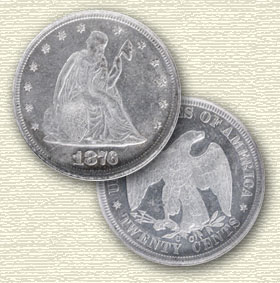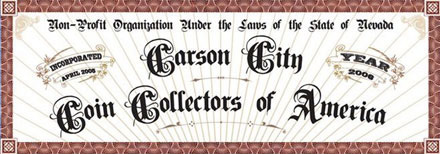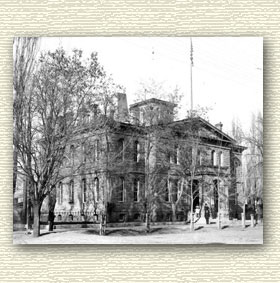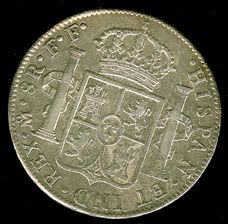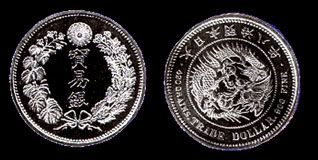- Posts: 499
- Thank you received: 0
1873-CC Trade $1 – CC Coin of the Week 10-26-09
16 years 1 week ago - 15 years 11 months ago #503
by Belayoff
1873 CC Trade Dollar – Carson City Coin of the Week.
The Coinage Act of 1873 is one of the most controversial monetary legislations ever passed by our nation’s Congress. The Act created several substantial changes, few of which proved valuable in the long run. The Act set the country on a gold standard, introduced the metric system of measurements to our coins, canceled seemingly important coin denominations and ultimately helped set in motion a world wide dumping of silver onto the market. The Crime of ’73 was justly blamed for a host of economic problems for many years to come but is rarely touted for one of its potentially good ideas… introducing, the Carson City Coin of the Week, the 1873 CC Trade Dollar.
This fascinating, short lived silver dollar coin was created to facilitate the burgeoning trade with China which, along with very few other countries was one of the few remaining trading partners willing to accept silver in large quantities. But why create a new “Silver Dollar” when we already had one in circulation? The simple reason is that the American, Seated Liberty Silver Dollar was generally being rejected by the oriental traders in favor of the old, Spanish 8 Real coin, better known to us as the Peso. A stronger, international US competitor with a completely different look was long overdue.
Peso means “weight” in Spanish and with about 377 grains of silver versus the American 371 grain Silver Dollar, the Peso had enough of a weight advantage to dominate trade.
American businesses were literally forced to buy these Spanish and Mexican produced coins in order to successfully trade with the Asians. But having to pay a 10% to 15% premium for these Spanish or Mexican silver coins was no great bargain either so, the pressure continued to build on our government to level the playing field. When on February 12, 1873 President Grant finally signed the 1873 Coinage Act, the long debated and greatly needed Trade Dollar, with 420 grains of silver, was born.
Most of the 124,500 Trade Dollars minted at the Carson City were shipped across the Pacific Ocean for trade. Today, estimated numbers of surviving coins in all grades is thought to be around 1,000 with approximately 60 in uncirculated condition. There appear to be only two examples of “gem” uncirculated examples known and both are in MS 65 holders. Sales of uncirculated examples over the last two years range from $6,325 for an MS 61, $8,000 to $10,925 for two MS 62 graded coins, and jumping way up to $25,000 to $29,000 for MS 63 and MS 64 sales. Remarkably, our C4OA web site auction records show a raw, uncirculated 1873 CC Trade Dollar selling for over $74,000 way back in 2001! Perhaps this coin is now in one of the two MS 65 holder! At the other end of the spectrum, a handsome F15 example recently sold for $605, but there not many to be found in that grade range without chop marks.
The example 1873-CC Trade Dollar in the photograph has excellent eye appeal and was graded by NGC at AU-58. The coin shows off its pinpoint strike through a lovely champagne colored patina. As expected for the grade, this Carson City produced Trade Dollar has its share of small abrasions and some well hidden hairline scratches on the reverse, though none of these are distracting.
There is only one die marriage Type of 1873CC Trade Dollar and all 124,500 coins minted that year were produced with a small “CC” mint mark. This little “CC coin of the Week” article barely scratches the surface of the full pre-history of the 1873 CC Trade Dollar. The full story is complicated and involves ample amounts of politics and business with healthy doses of intrigue at near every level. For myself I find the 1873 CC Trade Dollar a singularly beautiful and impressive US coin with quite a lot of up-side value potential.
Belay Off
C4OA Lifer!
1873-CC Trade $1 – CC Coin of the Week 10-26-09 was created by Belayoff
1873 CC Trade Dollar – Carson City Coin of the Week.
The Coinage Act of 1873 is one of the most controversial monetary legislations ever passed by our nation’s Congress. The Act created several substantial changes, few of which proved valuable in the long run. The Act set the country on a gold standard, introduced the metric system of measurements to our coins, canceled seemingly important coin denominations and ultimately helped set in motion a world wide dumping of silver onto the market. The Crime of ’73 was justly blamed for a host of economic problems for many years to come but is rarely touted for one of its potentially good ideas… introducing, the Carson City Coin of the Week, the 1873 CC Trade Dollar.
This fascinating, short lived silver dollar coin was created to facilitate the burgeoning trade with China which, along with very few other countries was one of the few remaining trading partners willing to accept silver in large quantities. But why create a new “Silver Dollar” when we already had one in circulation? The simple reason is that the American, Seated Liberty Silver Dollar was generally being rejected by the oriental traders in favor of the old, Spanish 8 Real coin, better known to us as the Peso. A stronger, international US competitor with a completely different look was long overdue.
Peso means “weight” in Spanish and with about 377 grains of silver versus the American 371 grain Silver Dollar, the Peso had enough of a weight advantage to dominate trade.
American businesses were literally forced to buy these Spanish and Mexican produced coins in order to successfully trade with the Asians. But having to pay a 10% to 15% premium for these Spanish or Mexican silver coins was no great bargain either so, the pressure continued to build on our government to level the playing field. When on February 12, 1873 President Grant finally signed the 1873 Coinage Act, the long debated and greatly needed Trade Dollar, with 420 grains of silver, was born.
Most of the 124,500 Trade Dollars minted at the Carson City were shipped across the Pacific Ocean for trade. Today, estimated numbers of surviving coins in all grades is thought to be around 1,000 with approximately 60 in uncirculated condition. There appear to be only two examples of “gem” uncirculated examples known and both are in MS 65 holders. Sales of uncirculated examples over the last two years range from $6,325 for an MS 61, $8,000 to $10,925 for two MS 62 graded coins, and jumping way up to $25,000 to $29,000 for MS 63 and MS 64 sales. Remarkably, our C4OA web site auction records show a raw, uncirculated 1873 CC Trade Dollar selling for over $74,000 way back in 2001! Perhaps this coin is now in one of the two MS 65 holder! At the other end of the spectrum, a handsome F15 example recently sold for $605, but there not many to be found in that grade range without chop marks.
The example 1873-CC Trade Dollar in the photograph has excellent eye appeal and was graded by NGC at AU-58. The coin shows off its pinpoint strike through a lovely champagne colored patina. As expected for the grade, this Carson City produced Trade Dollar has its share of small abrasions and some well hidden hairline scratches on the reverse, though none of these are distracting.
There is only one die marriage Type of 1873CC Trade Dollar and all 124,500 coins minted that year were produced with a small “CC” mint mark. This little “CC coin of the Week” article barely scratches the surface of the full pre-history of the 1873 CC Trade Dollar. The full story is complicated and involves ample amounts of politics and business with healthy doses of intrigue at near every level. For myself I find the 1873 CC Trade Dollar a singularly beautiful and impressive US coin with quite a lot of up-side value potential.
Belay Off
C4OA Lifer!
Last edit: 15 years 11 months ago by Belayoff. Reason: code verify
Please Log in to join the conversation.
16 years 1 week ago - 16 years 1 week ago #504
by LITAS
1780 8-real coin from Mexico mint.
In this particular coin the reverse is about 15 degrees to the right.
These coins were produced by over a dozen different mints from Mexico to South America. They were generally known as "Spanish milled dollars" and were truly an international coin. The Trade Dollar was created to compete with
the 8-real coin. To give the American trade dollar an edge, extra
7.5 grains of silver were added to the trade dollar. Chinese liked that.
Americans were not the only ones that tried to compete with the
Spanish silver coins. Japanese issued their own Trade Dollar for the
same purpose.
Not to be outdone by the Americans, Japanese Trade Dollar also
had 420 grains of silver.
Great topic, Bruce.
John Armonas
Replied by LITAS on topic Re:1873-CC Trade $1 – CC Coin of the Week 10-26-09
1780 8-real coin from Mexico mint.
In this particular coin the reverse is about 15 degrees to the right.
These coins were produced by over a dozen different mints from Mexico to South America. They were generally known as "Spanish milled dollars" and were truly an international coin. The Trade Dollar was created to compete with
the 8-real coin. To give the American trade dollar an edge, extra
7.5 grains of silver were added to the trade dollar. Chinese liked that.
Americans were not the only ones that tried to compete with the
Spanish silver coins. Japanese issued their own Trade Dollar for the
same purpose.
Not to be outdone by the Americans, Japanese Trade Dollar also
had 420 grains of silver.
Great topic, Bruce.
John Armonas
Last edit: 16 years 1 week ago by LITAS.
Please Log in to join the conversation.
16 years 1 week ago #505
by Belayoff
C4OA Lifer!
Replied by Belayoff on topic Re:1873-CC Trade $1 – CC Coin of the Week 10-26-09
John,
Thank you for the great follow up information and photos. I did not know that about Japan but it makes sence.
Belay Off
Thank you for the great follow up information and photos. I did not know that about Japan but it makes sence.
Belay Off
C4OA Lifer!
Please Log in to join the conversation.
Time to create page: 0.110 seconds
